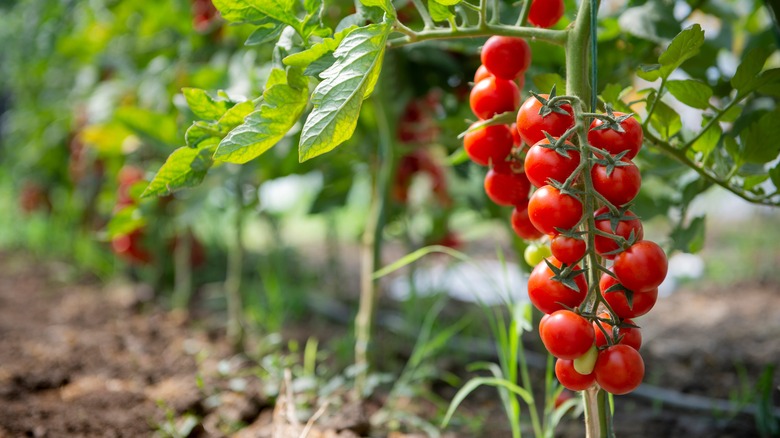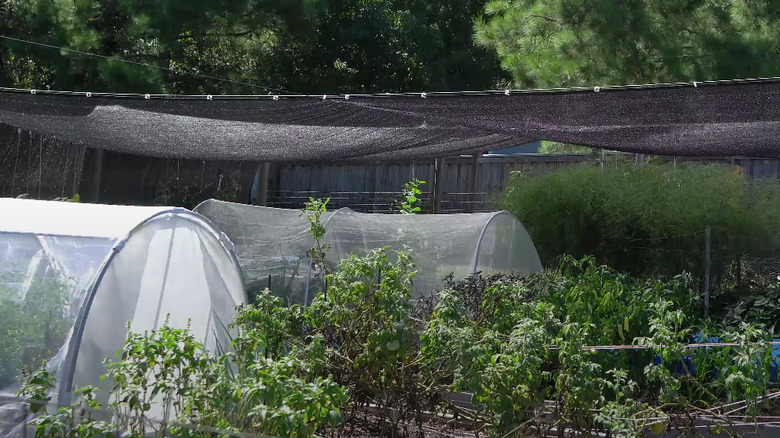DIY A Sun Shade For Your Garden To Keep Plants Cool On Those Extra Hot Days
We may receive a commission on purchases made from links.
If your garden doesn't have a lot of natural shade, you may find it difficult to protect certain plants during the summer months. If this sounds familiar, you're probably wondering how to shield them from negative impacts. Well, as it turns out, there could be an easy way to fix this. The solution? Make your own DIY sunshade, as shown by @mygardenburner on TikTok. By making your own, you could save some money and help certain areas of your garden make it through the hotter months of the year so you can reap all their benefits.
Fall is a great time to start gardening so you can prepare your sun shades at the same time. For example, you may want to protect broccoli, beet, chive, carrots, pea, and leek plants or flowering options such as pansies, primroses, and snowdrops. However, there will be plenty more that prefer shade, so make sure to check before you commence this DIY to make any appropriate accommodations.
If you have several spots that will benefit from this project then make multiple of them to complete the job. You'll want to buy some PVC pipe, heavy-duty zip ties, a tape measure, scissors, a shade cloth, a saw, PVC pipe connectors, and caps. You can grab some PVC pipe from The Home Depot for $8.48, some connectors for $13.90, and a shade cloth for $29.98. Purchase heavy-duty zip ties off Amazon for $7.99.
How to make your DIY sun shade
Making this DIY is fairly straightforward. First, you want to start by taking your tape measure and noting down how big you will need your DIY sunshade to be, allowing room for the PVC pipes. You should leave plenty of extra room when you measure to ensure the area will receive plenty of shade.
Now, you need to use your saw to slice eight pieces of PVC pipe, including four legs, and then four pieces to create a square and connect all the legs at the top. Take your four legs and add one connector piece per leg at the top, with two open holes sticking in opposite directions, before adding a base on the opposite end of each leg. Ensure each leg is in place and standing on its base around your chosen area, and insert the rest of your frame pieces.
Now that you have your frame in place, drape your cloth over, leaving no gaps (double-check there are no holes in the product before you complete this step). When you're sure it's in good condition, use your heavy-duty zip ties on each corner to ensure that it stays in place and that you get full coverage of the area you desire. In case you don't have any zip ties, use twine, string, or some thin rope.
If you have a vegetable garden, then this is a perfect opportunity to make it thrive. However, you can use this on flowers too.
How the DIY sun shade works
This DIY shade works because blocking the sun means that your plants and crops will be less dehydrated compared to the surrounding areas of your yard. In turn, this will help keep them cool and thriving, which is exactly what you want in order to maintain their good quality.
If your plants are too hot or dry, you may see giveaway indicators such as dry leaves and wilting, discoloration, or any unusual textures or blisters. That is why providing your plants with a shadier area to protect them from the sun is vital to making the most of your garden. In the case where you're unsure what to keep an eye out for, it's best to verify via sources online or with a professional. If you have plenty of gardening books, then these may be able to help you too.
If you can't do this DIY for whatever reason then improvise where possible; for example, use a gazebo or an umbrella. You could also use some wooden stakes or sticks if you have any in your garage or shed and utilize some old material you have to drape over the top. Just ensure you secure it so it doesn't blow away and the area you cover is large enough.

